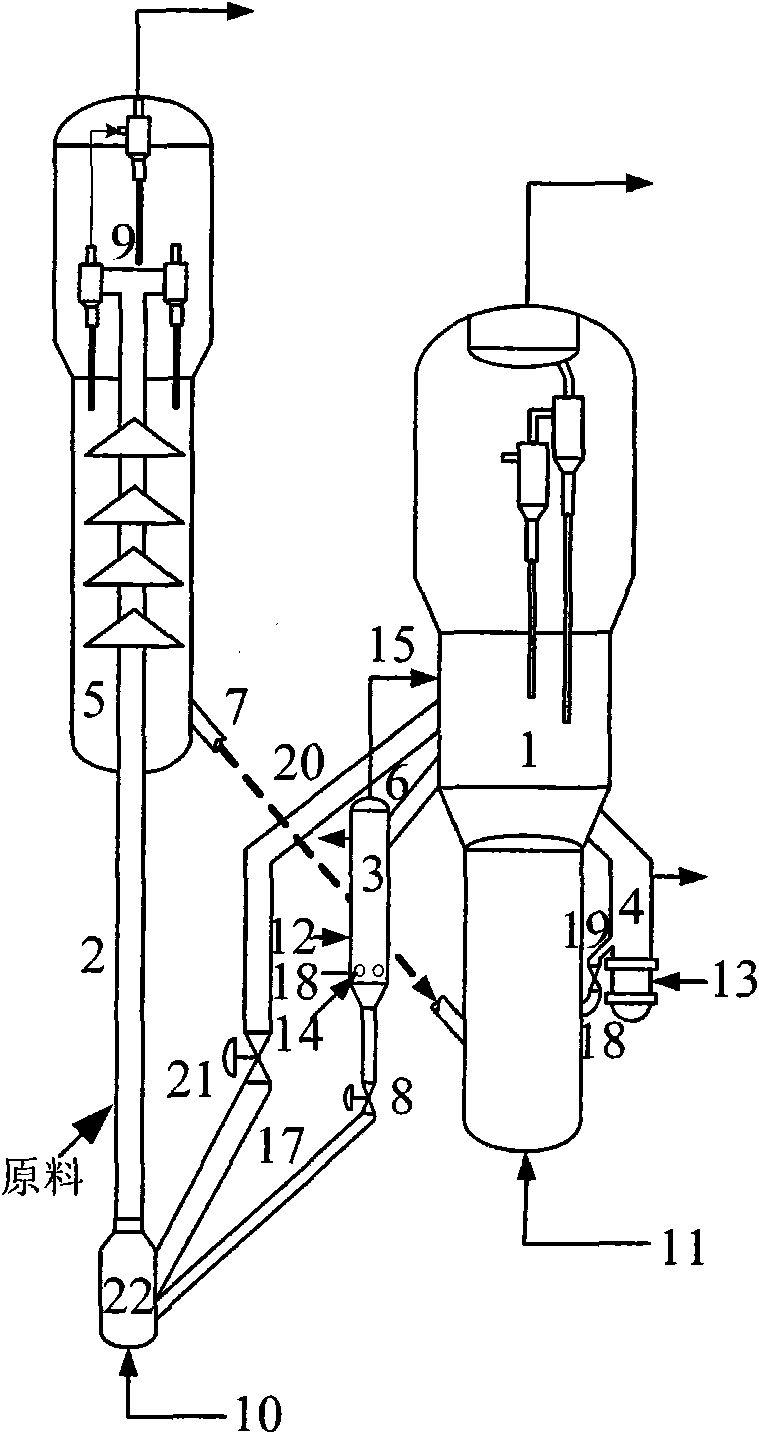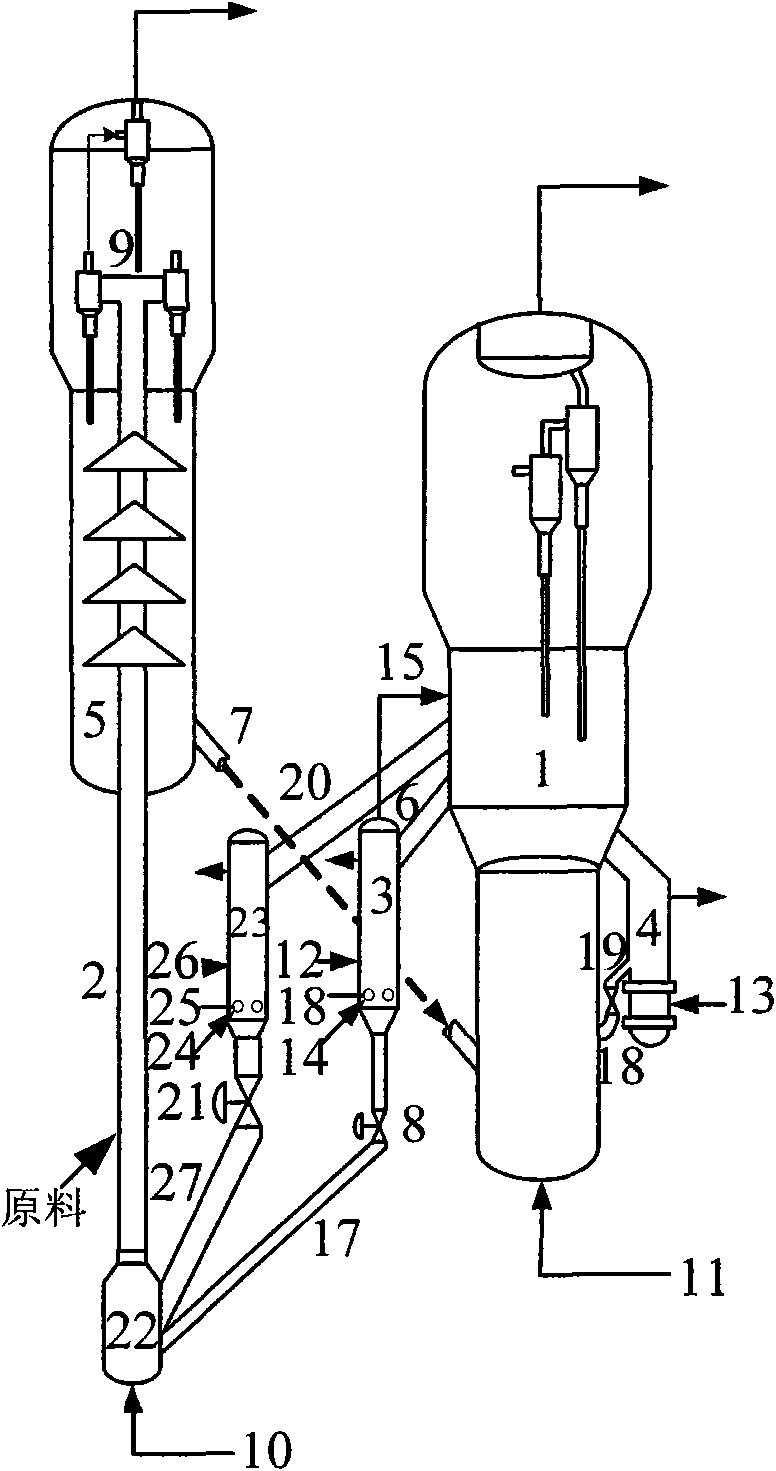Method for flexibly adjusting catalytic cracking reaction-regeneration system heat balance
A regeneration system, heat balance technology, applied in catalytic cracking, cracking, petroleum industry and other directions, can solve the problems of flexible adjustment of catalyst material level, fixed heat load, and reduction of average density without considering the adjustment of heat extractor.
- Summary
- Abstract
- Description
- Claims
- Application Information
AI Technical Summary
Problems solved by technology
Method used
Image
Examples
specific Embodiment approach 2
[0023] The process of the present invention can also be seen figure 2 , briefly described as follows: a conventional catalyst heat collector 4 is arranged on the regenerator 1 of the heavy oil catalytic cracking unit, and a part of the high-temperature catalyst in the regenerator 1 (accounting for 1% to 20% of the regenerator catalyst inventory) enters the conventional catalyst to obtain heat The regenerator 4 exchanges heat with the cooling medium 13 (water or low-pressure steam) and returns to the regenerator through the catalyst delivery pipe 18 and the catalyst flow control valve 19. The opening is regulated, and the amount of heat taken is regulated by the circulation amount of the catalyst entering the heat extractor and the flow of the cooling medium 13 (water or low-pressure steam). The low-temperature catalyst (550-660°C) returned to the regenerator is mixed with the high-temperature catalyst in the regenerator to realize the adjustment of the catalyst bed temperatur...
specific Embodiment approach 3
[0027] The process of the present invention can also be seen image 3 , briefly described as follows: a conventional catalyst heat collector 4 is arranged on the regenerator 1 of the heavy oil catalytic cracking unit, and a part of the high-temperature catalyst in the regenerator 1 (accounting for 1% to 20% of the regenerator catalyst inventory) enters the conventional catalyst to obtain heat The regenerator 4 exchanges heat with the cooling medium 13 (water or low-pressure steam) and returns to the regenerator through the catalyst delivery pipe 18 and the catalyst flow control valve 19. The opening is regulated, and the amount of heat taken is regulated by the circulation amount of the catalyst entering the heat extractor and the flow of the cooling medium 13 (water or low-pressure steam). The low-temperature catalyst (550-660°C) returned to the regenerator is mixed with the high-temperature catalyst in the regenerator to realize the adjustment of the catalyst bed temperature...
Embodiment 1
[0037] For verifying the effect of the present invention, adopt figure 2 The technological process shown is carried out industrial test on a 400,000 ton / year heavy oil catalytic cracking unit of a refinery, and the test results are listed in Table 1.
[0038] After adopting this invention, under the condition that the catalyst bed temperature of the regenerator is kept at 690°C, the regenerated catalyst entering the riser reactor is cooled to 660°C, the oil agent mixing temperature is 560°C, and the agent-oil ratio is increased from 6 to 9, The reaction temperature was maintained at 490°C, so that the yield of light oil increased by 2.3 percentage points, and the yield of dry gas and coke decreased significantly. See Table 1 for details.
[0039] Table 1 Properties of heavy oil raw materials
[0040] project
data
project
data
Density(20℃)kg / m 3
945
Nitrogen content, ppm
2000
Carbon residue, wt%
5.4
Hydrocarbon Grou...
PUM
 Login to View More
Login to View More Abstract
Description
Claims
Application Information
 Login to View More
Login to View More - R&D
- Intellectual Property
- Life Sciences
- Materials
- Tech Scout
- Unparalleled Data Quality
- Higher Quality Content
- 60% Fewer Hallucinations
Browse by: Latest US Patents, China's latest patents, Technical Efficacy Thesaurus, Application Domain, Technology Topic, Popular Technical Reports.
© 2025 PatSnap. All rights reserved.Legal|Privacy policy|Modern Slavery Act Transparency Statement|Sitemap|About US| Contact US: help@patsnap.com



